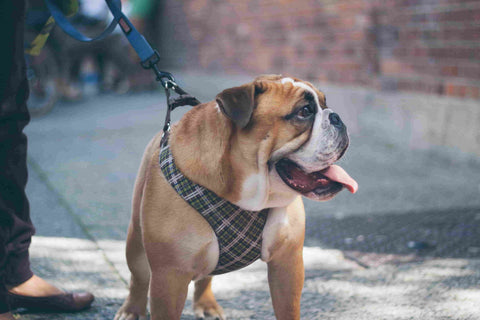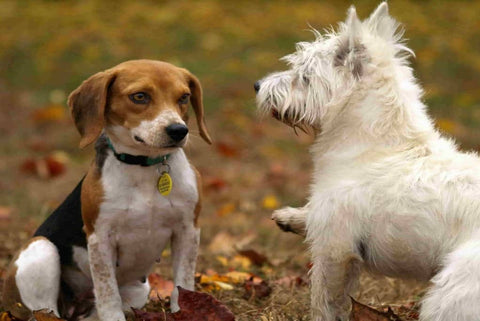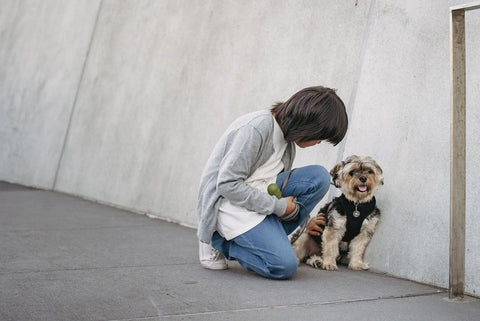Our Guide To No-Pull Harnesses for Large Dogs
When you have a big dog, pulling can be a potentially dangerous issue. Big dogs who pull when you’re walking on a leash are putting themselves and you at risk.
Large dog breeds can have a lot of force and power. A no-pull dog harness is the best training tool to give you control even over a very large dog, but also to help train him not to pull at all.
When you’re looking for the best no-pull harness, you have to consider the fit to ensure that it’s going to be able to function properly. At Pet&Cuddle, we regularly work with owners of large dogs who want the best harness that they can use as a training tool and throughout their daily lives.
We understand how to help you get the perfect fit. We encourage you to take a look at our guide on no-pull dog harnesses for large dogs before you make a buying decision.
Essential Features for Choosing a No-Pull Dog Harness for Large Breeds
We often have people come to us, and they want to deal with their dog’s pulling, but they don’t know where to get started. We recommend harnesses, but not just any option will work for the pulling.
The ideal no-pull dog harness for large dogs is one with a front clip leash attachment.
To understand how to use a no-pull dog harness, it’s helpful to have an idea of how they work.
- First, if you were to use just a traditional collar, then a dog that pulls and especially a big one, is going to be putting too much tension on their neck as they’re straining to go forward. That can lead to injuries and pain.
- With a no-pull harness that has a front clip, your dog has to stay close to you to keep going forward.
- If a dog pulls when attached to a harness with a front clip, the leash will go to the side. The leash won’t go straight back. That then brings your dog back to you. What this means is you can apply just a little gentle pressure and get your dog back to you. You have control the entire time.
- Since the front clip is at the chest, you can pivot your dog with only a bit of a pull giving you directional steering capabilities.
- With a no-pull harness, you’re also utilizing a squeeze and lift approach. This means the uncomfortable feeling that your dog experiences if they do try to pull, will help them learn not to do it.
- As part of your training, you can start to reward your dog for proper walking technique. For example, if your dog is checking in with you as you’re walking with the no-pull harness, reward that. You can reward your dog not just by giving him your attention but also adding some slack to the leash.
Along with the front clip that characterizes a no-pull leash, there are a few other things to keep in mind when you’re choosing one for your dog.
What is the Material?
The best no-pull harness is going to be one that’s comfortable for your dog and made of a material that’s soft and breathable. If your dog isn’t comfortable when you’re walking for any reason, this is going to encourage bad behavior.
Is It Adjustable?
No matter your dog’s size, getting the right fit is one of the most important things you can do when you buy a new harness. If it doesn’t fit well, it won’t be safe or effective. As well as taking your dog’s measurements, look for an adjustable harness so you can get it just right.
How Easy Is It To Put On?
If you choose a dog harness that’s too fussy or complicated, it’ll be frustrating for you, and it might make your dog try to avoid wearing it. A good harness should take no more than a minute to put on fully.
Is It Lightweight?
A bulky, heavy and generally cumbersome harness won’t do you any favors. Think about choosing one that’s lightweight enough that you can take it on the go without a second thought.
Is It Safe for Dogs?
What we always tell people is that a harness is going to be the safer option compared to a collar. It disperses pressure around your dog’s entire body, reducing the risk of neck and trachea injuries.
Advanced Features to Look For in a Dog Harness
The features above are absolute must-haves, but there are a few other things to look for in a dog harness as well.
- Reflective Straps: Do you like walking at night, maybe as a way to unwind after work? You might prefer going out with your dog during the early morning before the world wakes up. Either way, safety is important, so look for a harness with reflective straps or detailing.
- Multiple Clips: Above, we talked about using a front clip harness if you’re working on teaching your dog not to pull. You won’t need that forever, however. Once your dog is trained, you can start to use a back clip which gives more freedom. If you choose a harness with both types of clips, you’ll get more functionality and longevity.
- Soft, Flexible Materials: Some cushioning is going to alleviate chafing and discomfort. A comfortable dog is going to get more from their training sessions and also enjoy their leisurely walks more.
How To Use a No-Pull Dog Harness for Large Dogs
Without getting the right fit, learning how to use a no-pull dog harness is going to be impossible. Proper fit is critical, and we can walk you through each step you should follow to ensure that you get the right size for your big dog.
We’d also like to make a note about the importance of getting actual measurements versus relying on weight alone. We frequently hear from customers that they just go by weight when they’re choosing dog gear, including harnesses.
The issue with that is while weight can give you a general guideline, it doesn’t tell the full story. Dogs can be the same weight but have very different builds. For example, chest girth can be different. A dog with a broad chest may weigh the same as one with a narrower chest build, but they’re likely going to need different-sized harnesses.
Follow the steps below to get your dog’s measurements.
- First, get a tape measure. If you don’t have a tape measure, you can use a ruler and string or something soft you can wrap around your dog.
- Next, take a measurement of your dog’s chest. Start at the widest point of the bottom of the rib cage just behind your dog’s legs. Loop your tape measure up and around, bringing it back to where you started. The tape measure should be snug but not overly tight when you’re getting measurements.
- Now, measure your dog’s lower neck. This is not the same place a collar would sit—it’s further down at the widest point. Wrap your tape measure around this area.
- Then, you can measure your dog’s length, starting behind the front leg and bringing the tape measure in a straight line to right behind the back leg.
- Once you’ve done the steps above, take a look at the Pet&Cuddle size chart.
Tips for Achieving a Proper Fit
A few extra tips to get that just-right fit include:
- Tip #1: If you look at the harness size chart and your dog falls in the middle between two sizes, we always recommend going up. Use your judgment, however.
- Tip #2: Once your harness arrives, put it on and adjust the straps. Then, confirm the fit by slipping any two fingers between any two straps of the harness. You should be able to do this, but the harness should feel snug when you do. You can also attempt to pull it over your dog’s head, which you should not be able to do if it’s secure and well-fitted.
Pet&Cuddle features no-pull harnesses for pit bulls and other breeds that are large, so we encourage you to browse the selection.
What Are the Benefits of Using No-Pull Harnesses For Large Dogs?
If you have a big dog and especially one that’s prone to pulling, we want to emphasize how much you’ll benefit from using a harness. It’s going to be the option that will provide you with safety and control, and you’re likely to notice big improvements in your dog’s walking behavior after you start using one.
- Control: Big dogs are notoriously hard to control on walks. It can be painful for you if you’re using a collar, as it puts a lot of strain on your neck, arm, and back. Your dog may seem out of control, which can make you less inclined to go on walks. If you don’t have control of a big dog and he gets near other people or animals, it can also be problematic and scary. Using a no-pull dog harness for large dogs is a good way to alleviate all of these problems and give you control. There are pressure points around your dog’s entire body, and when you use the front clip your dog is being guided to stay close to you and you can maneuver him directionally.
- Training: You don’t have to just accept that your dog pulls while you’re on walks. You can train him so that he doesn’t do this anymore, using a harness.
- Safety: You love your dog, and the thought of injuring him is probably incredibly upsetting to you. With a harness, big dogs are less likely to get hurt compared to a collar. They’re also less likely to escape.
- Functionality: When you have equipment that works well and is beneficial for you and your dog, you’re going to be encouraged to walk more. That means more exercise for your dog, which is a booster for mental and physical health. Plus, if you get a dual-clip leash, you can use the front or back clip as you need to.
Can I Use a No Pull Dog Harness and a Retractable Leash Together?
We often hear from people who wonder if they can use a no-pull dog harness and a retractable leash together. Separately, these are two of our most recommended and popular products.
With that in mind, we wrote an entire post about the topic, but we’ll sum it up here.
- The short answer is that yes, you can use a no-pull harness with a retractable leash, with a few caveats.
- Retractable leashes have a lot of advantages over a fixed-length option. They let your dog explore their environment, and you have versatility in your level of control.
- With that in mind, if your dog is still training and learning not to pull when you’re using a front clip attachment and a retractable leash, don’t let the leash generate tension on the clip.
- When there’s tension generated on the front clip, it confuses your dog. There’s a sensation that he’s pulling but he’s not.
- You can use a fixed-length on the leash to squeeze and lift instead. Then, your dog will have a hard time pulling on the lead.
Should You Really Use a Harness For Large Dogs?
There is no better option than using a harness for large dogs. This is going to offer the most safety and control. You’re not going to have to worry about injuring your dog or them getting free. It’s more comfortable for you, and you can enjoy your walks and simultaneously work on training techniques.
As the ultimate dog lovers, our team at Pet&Cuddle has created a unique no-pull harness collection for your large dogs, which is safe yet can be used for training, leading, or adapting your pet for walking with a leash.
Discover the best dog harnesses we created exactly for your dog here.
Questions About Dog Harnesses
We love to talk to our customers and answer questions they have about dog gear, safety, and general wellness for their pets. We put together some of the questions we get about harnesses for big dogs in particular and our answers to those.
Is It Safe to Use No-Pull Harnesses For Big Dogs?
Not only is it safe to use no-pull harnesses for big dogs, but it’s actually safer than using a collar. When you use a collar, it’s going to put a lot of pressure on your dog’s throat and neck. Even if your dog doesn’t pull, that’s dangerous, but if he does, there’s a risk of serious injury.
A no-pull dog harness doesn’t do that. There are pressure points around the body rather than focusing it all at any one point.
When you measure and get the right fit, a no-pull dog harness is incredibly safe and is preferable over a collar.
How Tight Should a No-Pull Harness Be?
We encourage you to double-check the tightness of a harness in a couple of ways. First, use the finger trick we talked about above. Take two fingers and slide them underneath any of the straps of the harness once it’s on your dog and adjusted.
Your fingers should fit under the strap but snugly.
You might also want to take a look at how your dog is walking in his harness once it’s adjusted. Does it seem to limit his range of motion in any way? If so, the fit might be off.
What’s Better: Harnesses or Collars for Large Dogs?
We highly recommend a harness instead of a collar for large dogs and dogs of all sizes, for that matter. Your dog is going to be happier, more comfortable and safer. Plus, you’re going to have more control so you’ll feel at ease and relaxed as you walk.
Can a Dog Wear Harnesses All the Time?
There’s no reason for a dog to wear a harness all the time, and we advise against it. A harness is a walking and training tool. If your dog’s wearing it all day, it’s going to be irritating and uncomfortable. Use it when you need it only.
Get the Best No-Pull Harness for Large Dogs on Pet&Cuddle
We love what we do at Pet&Cuddle. We create the best gear for dogs, and we get to help people just like you make the best decisions.
When you follow the guide above you can find the best no-pull dog harness and use it safely while getting all the benefits that come with it. Take your dog’s measurements and start shopping, or reach out and we can help you get started.
We are true dog lovers, and we’re always working on perfecting our harness collections which are safe, functional, versatile, and work well for training, adapting or leading. Discover everything we have to offer here.




